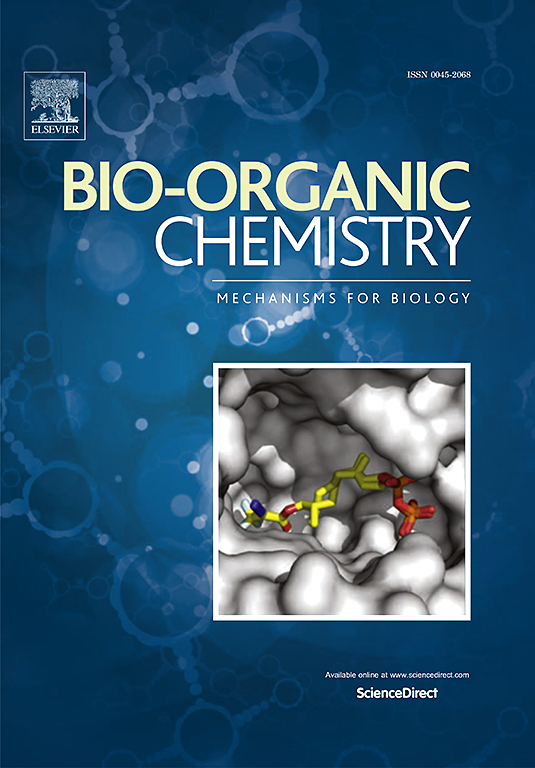Structure-based molecular hybridization design and synthesis of Keap1-Nrf2 inhibitors for anti-inflammatory treatment
IF 4.5
2区 医学
Q1 BIOCHEMISTRY & MOLECULAR BIOLOGY
引用次数: 0
Abstract
The Kelch-like ECH-associated protein 1 (Keap1)-nuclear factor erythroid 2-related factor 2 (Nrf2) signaling pathway stands as a pivotal mechanism in defending against oxidative stress damage and related inflammation. Blocking the Keap1-Nrf2 protein-protein interaction (PPI) offers a promising therapeutic approach for treating diseases related to oxidative stress and inflammation. Our group previously reported NXPZ-2, a naphthalene sulfonamide derivative targeting Keap1, which effectively inhibits the Keap1-Nrf2 PPI, thereby releasing Nrf2 to exert its anti-inflammatory and antioxidant effects. In the present work, we employed a structure-based molecular hybridization strategy to design a series of novel naphthalene sulfonamides by combining NXPZ-2 with the Nrf2 activator dimethyl fumarate (DMF) or its analogues. Among these new derivatives, compound 1c, specifically (Z)-4-((4-(N-(2-amino-2-oxoethyl)-N-(4-((N-(2-amino-2-oxoethyl)-4-methoxyphenyl)sulfonamide)naphthalen-1-yl) sulfamoyl)phenyl)amino)-4-oxobut-2-enoic acid, exhibited the highest PPI inhibitory activity, with a KD2 value of 0.119 μM. In an LPS-induced RAW264.7 cell model, this compound mitigated LPS-induced cellular damage, suppressed the expression of pro-inflammatory cytokine TNF-α and IL-6, and significantly elevated the intracellular GSH and SOD enzyme activities. Furthermore, in an LPS-induced acute lung injury (ALI) mouse model, the compound demonstrated a remarkable ability to alleviate oxidative damage and inflammation in the lungs. In conclusion, this novel naphthalene sulfonamide represents a promising drug candidate for Keap1-targeting therapy in ALI. Molecular docking analysis revealed that the amide and maleic acid groups of 1c facilitate strong interactions with the Kelch domain of Keap1, explaining the compound's preference for binding through hydrogen bonding and π-π stacking interactions.

求助全文
约1分钟内获得全文
求助全文
来源期刊

Bioorganic Chemistry
生物-生化与分子生物学
CiteScore
9.70
自引率
3.90%
发文量
679
审稿时长
31 days
期刊介绍:
Bioorganic Chemistry publishes research that addresses biological questions at the molecular level, using organic chemistry and principles of physical organic chemistry. The scope of the journal covers a range of topics at the organic chemistry-biology interface, including: enzyme catalysis, biotransformation and enzyme inhibition; nucleic acids chemistry; medicinal chemistry; natural product chemistry, natural product synthesis and natural product biosynthesis; antimicrobial agents; lipid and peptide chemistry; biophysical chemistry; biological probes; bio-orthogonal chemistry and biomimetic chemistry.
For manuscripts dealing with synthetic bioactive compounds, the Journal requires that the molecular target of the compounds described must be known, and must be demonstrated experimentally in the manuscript. For studies involving natural products, if the molecular target is unknown, some data beyond simple cell-based toxicity studies to provide insight into the mechanism of action is required. Studies supported by molecular docking are welcome, but must be supported by experimental data. The Journal does not consider manuscripts that are purely theoretical or computational in nature.
The Journal publishes regular articles, short communications and reviews. Reviews are normally invited by Editors or Editorial Board members. Authors of unsolicited reviews should first contact an Editor or Editorial Board member to determine whether the proposed article is within the scope of the Journal.
 求助内容:
求助内容: 应助结果提醒方式:
应助结果提醒方式:


